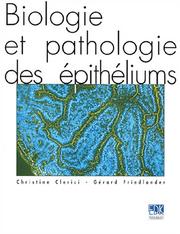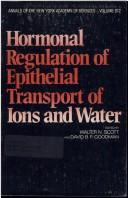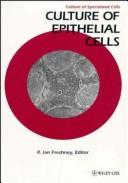| Listing 1 - 9 of 9 |
Sort by
|

ISBN: 2842540417 9782842540418 Year: 2000 Publisher: Paris: EDK,
Abstract | Keywords | Export | Availability | Bookmark
 Loading...
Loading...Choose an application
- Reference Manager
- EndNote
- RefWorks (Direct export to RefWorks)

ISBN: 0897661958 9780897661959 Year: 1982 Volume: 401 Publisher: New York (N.Y.): New York Academy of Sciences,
Abstract | Keywords | Export | Availability | Bookmark
 Loading...
Loading...Choose an application
- Reference Manager
- EndNote
- RefWorks (Direct export to RefWorks)
Endothelium --- Congresses --- -#Lilly --- Epithelium --- #Lilly --- Endothelium - Congresses
Book
Year: 2001 Publisher: Bruxelles: UCL.,
Abstract | Keywords | Export | Availability | Bookmark
 Loading...
Loading...Choose an application
- Reference Manager
- EndNote
- RefWorks (Direct export to RefWorks)
Background. Ozone (O3) and nitrogen dioxide (NO2) are two highly reactive compounds that have already been shown to be injurious to human health, and particularly to the centro-acinar region of the lungs. Several studies have demonstrated that measurement of lung-specific secretory proteins in serum, fir instance the 16 kDa Clara cell protein (CC16) and the surfactant-associated protein A (SP-A) might be useful to assess alterations of the lung epithelial barrier following acute exposure to O3. However, no study has so far examined whether chronic exposure to photo-oxidants such as O3 and NO2 induces the same effects in humans.
Methods. 312 healthy non-smoking adults from areas with different ambient levels of O3 and NO2 were enrolled on this study. 78 subjects were from Cuernavaca North in the suburbs of Mexico, 95 were from Mexico City (Mexico) and 139 subjects from Paris (France). Each participant was followed for 5 days. NO2 exposure levels were assessed by personal passive monitors. Ambient O3 levels were measured by local monitoring stations. Blood samples were taken on days 5, in the morning, in order to assess the integrity of the lung epithelial barrier. CC16 was measured on the whole population. SP-A assay was performed on the Mexican population only.
Findings. Levels of ambient O3were singnificantly higher in the two Mexican areas (mean, 80 μg/m³/h) compared to Paris (mean, 30 μg/m³/h). No difference was however observed between the ambient NO2 concentrations. CC16 concentration in serum was on average 50% lower in the Mexican subjects compared to the subjects from Paris and showed an inverse dose-effect relationship with ambient O3 levels. By contrast, a slight increase in serum SP-A levels was found in the Mexican subjects and was positively correlated with O3 levels. CC16 and SP-A did not differ between the two Mexican groups.
Conclusions. This study shows that chronic exposure to O3 is associated with a decrease of CC16 I serum. As no relationship was observed with the NO2 concentrations, we assumed that O3 was the main constituent responsible for the observed effects. These observations, very similar to those observed within smokers suggest that chronic exposure to O3 is associated with epithelial lung injury
Air Pollution --- Environmental Exposure --- Lung Diseases --- Epithelium
Book
Year: 2011 Publisher: Bruxelles: UCL,
Abstract | Keywords | Export | Availability | Bookmark
 Loading...
Loading...Choose an application
- Reference Manager
- EndNote
- RefWorks (Direct export to RefWorks)
The eye is a spectacular sensory organ, known to be sophisticated. These last years, ophthalmology and ophtalmopharmacology have strongly progressed due to technological advances. For topically administered drugs, the first structure affected is the cornea. Therefore it forms the primary rate-limiting permeability barrier to compound absorption into the anterior chamber of the eye. Ocular drug absorption into anterior ocular tissue is determined either by passive diffusion, facilitated diffusion or by active transport. The scientific literature gives us information about the expression of many transporters in the corneal epithelium which can act as drug delivery system. We can classify transporters both as influx or efflux transporters. Efflux transporters include MRP1 4,5,6 and MDR1. They play an important role in the protection of ocular tissue, indeed, the mechanism of efflux enhance ocular drug penetration. Influx transporters include peptides transporters such as PEPTs, ATB0, +, LAT They may be particularly important in absorption, distribution and clearance of their drug substrate in the eye. The discovery of such transporters in the corneal epithelium is an interesting theme of research that cans enrich the field of ophatlmopharmacology. Indeed, understanding the substrate specificity and the structure- activity relationships of various transporter proteins might make it possible to design prodrugs that are targeted to specific transporter. This point of view is very important to develop new drugs which could treat ocular pathologies such as inflammations, infections and glaucoma. Research about cornea transporters move forward and continue to grow. It is evident that the knowledge about this subject is currently quite limited. Extensive studies are needed to clarify the role and clinical significance of drug transporters in the eye but the future is promising in this regard L’œil est un organe sensoriel spectaculaire et étonnamment sophistiqué. Ces dernières années, les avancées technologiques ont permis de faire des progrès considérables en ce qui concerne l’ophtalmologie et l’ophtalmopharmacologie. Lors de l’application topique de substances actives au niveau de l’œil, la première structure touchée est la cornée. Celle-ci forme une barrière limitante et perméable à l’absorption de substances actives au niveau de la chambre antérieure de l’œil. L’absorption de tels composés se fait donc selon différents phénomènes, tels qu’un transport passif, actif ou encore un transport facilité. L’analyse de la littérature scientifique nous apprend que la cornée exprime de façon non négligeable des transporteurs. On y retrouve des transporteurs à efflux tels que le MRP1,4,5,6, MDR1, qui jouent un rôle important au niveau de la protection des tissus oculaires, en empêchant toute pénétration de substance active. On retrouve également des transporteurs à influx de type peptidiques comme les PEPTs, ATB0, +, LAT, etc... Ceux-ci sont étroitement impliqués dans l’absorption, la distribution et la clairance d’un principe actif au niveau de l’œil. La découverte de ces transporteurs au niveau de la cornée offre une cible de recherche très intéressante et apporte ainsi une réelle avancée dans le domaine de l’ophtalmopharmacologie. En effet, en connaissant la spécificité des substrats et les relations de structure-activité entre le substrat et divers transporteurs, on peut facilement imaginer la création de prodrogues qui cibleraient de manière spécifique les transporteurs, où comment transformer une molécule incapable de traverser un transporteur en un substrat idéal? Ceci est particulièrement intéressant pour les pathologies oculaires telles que les inflammations, les infections et le glaucome. La recherche sur les transporteurs de la cornée va de l’avant et ne cesse de progresser. Cependant, les connaissances à ce sujet restent limitées et d’autres études sont nécessaires pour clarifier le rôle et l’importance clinique de ces transporteurs
Eye --- Epithelium, Corneal --- Membrane Transport Proteins --- Opthalmology
Book
Year: 1993 Publisher: Bruxelles: UCL.,
Abstract | Keywords | Export | Availability | Bookmark
 Loading...
Loading...Choose an application
- Reference Manager
- EndNote
- RefWorks (Direct export to RefWorks)
Des expériences menées par plusieurs laboratoires ont montré l’influence de certains cytokines (IFN-γ, TGF-β, TNF-α et IL-4) sur l’augmentation de l’expression constitutive de la composante sécrétoire (CS) par des lignées cellulaires épithéliales humaines (excepté IEC-6 = intestin de rat).
Puisque la souris et le rat représentent les modèles expérimentaux privilégiés en recherche biomédicale, nous avons voulu tester ces mêmes cytokines sur des lignées épithéliales de rat et/ou de souris, et si possible sur des hépatocytes ou des lignées d’hépatomes.
Nous avons d’abord développé deux ELISAs (rat, souris) permettant un dosage sensible et fiable de la CS dans les surnageants et/ou dans les lysats de culture cellulaire.
Ensuite, nous avons examiné diverses lignées cellulaires épithéliales de rat et de souris exprimant constitutivement de la CS. Le Dr. D. Kaiserlain (Institut Pasteur, Lyon) possédait une lignée cellulaire de souris (MODE-K) qui, selon elle, exprimait constitutivement la CS (résultats obtenus au FACS). Avec notre ELISA nous n’avons pas détecté de CS, ni dans les surnageants de culture concentrés 10, 20 et 30 x, ni dans les lysats cellulaires. Nous avons essayé de confirmer, avec des méthodes (FACS), la présence de CS à la surface et dans les cellules MODE-K. Nos résultats montrent plutôt une fixation non spécifique de IgC de lapin sur ces cellules.
Les hépatocytes de rat étant bien connus pour exprimer la CS in vitro, nous avons voulu les utiliser en culture primaire. Les résultats obtenus ne permettent pas de voir une influence de l’IFN-γ, du TGF-β, et de l’IL-4 sur l’expression constitutive, déjà forte au départ, de la CS. Soulignons toutefois que les conditions de l’unique culture testée n’étaient pas optimales.
Dans un second temps, nous avons testé plusieurs surnageants de culture d’hépatomes de rat ainsi que d’autres lignées de cellules épithéliales muqueuses afin d’y détecter la CS. Nos expériences furent vaines quant à la détection de CS dans les milieux de culture et lysats cellulaires des lignées CMT 93 et CMT 64/61 du Dr. Kilshaw (Insitute of Animal Physiology and Genetics Research, Cambridge). Par contre, nous avons ou détecter de la CS dans les milieux de culture et les lysats des cellules Fao (hépatocarcinome de rat) et WIF (hybride entre une cellule Fao et un fibroblaste humain WI38) (Dr. D. Cassio, Insitut Curie, Paris). Les cellules WIF ayant un temps de dédoublement très long (70h), nous n’avons pu tester l’influence des cytokines sur l’expression constitutive de la CS dans le temps qui nous restait. Les expériences réalisées sur la lignée Fao suggèrent que l’IFN-γ (100 UI/ml) augmenterait leur expression constitutive de la CS. Par contre, le TGF-β et l’IL-4 n’auraient pas cet effet
Epithelium --- Cytokines --- Secretory Component --- Medical Laboratory Science --- Rodentia

ISBN: 0897661338 0897661346 9780897661331 Year: 1981 Volume: 372 Publisher: New York (N.Y.): New York Academy of Sciences,
Abstract | Keywords | Export | Availability | Bookmark
 Loading...
Loading...Choose an application
- Reference Manager
- EndNote
- RefWorks (Direct export to RefWorks)
Animal physiology. Animal biophysics --- Mammals --- Epithelium --- Biological transport, Active --- Hormones --- Water-electrolyte balance (Physiology) --- Congresses --- Physiological effect --- Endocrine aspects --- Epithelium - Congresses --- Biological transport, Active - Congresses --- Hormones - Physiological effect - Congresses --- Water-electrolyte balance (Physiology) - Endocrine aspects - Congresses --- EPITHELIUM --- BIOLOGICAL TRANSPORT, ACTIVE --- HORMONES --- WATER-ELECTROLYTE BALANCE (PHYSIOLOGY) --- PHYSIOLOGICAL EFFECT
Book
ISBN: 0471928038 9780471928034 Year: 1991 Publisher: Chichester: Wiley,
Abstract | Keywords | Export | Availability | Bookmark
 Loading...
Loading...Choose an application
- Reference Manager
- EndNote
- RefWorks (Direct export to RefWorks)
Cell adhesion --- Cellules --- Adhésivité --- Cell adhesion. --- 576.52 --- Adherence, Cell --- Cell adherence --- Adhesion --- Cell interaction --- Membrane fusion --- Junctional complexes (Epithelium) --- Phenomena at cell surfaces. Cell adhesion. Cell contacts --- 576.52 Phenomena at cell surfaces. Cell adhesion. Cell contacts --- Adhésivité

ISBN: 0471561029 9780471561026 Year: 1992 Publisher: New York (N.Y.): Wiley,
Abstract | Keywords | Export | Availability | Bookmark
 Loading...
Loading...Choose an application
- Reference Manager
- EndNote
- RefWorks (Direct export to RefWorks)
General embryology. Developmental biology --- Epithelial cells. --- Cell culture. --- Epithelium --- Cells, Cultured. --- Cell Differentiation. --- Cultures and culture media. --- cytology. --- Epithelial Cells. --- Epithelial cells --- -57.086.83 --- 611.018.7 --- Tissues --- Cilia and ciliary motion --- Cells --- Exfoliative cytology --- Adenomatous Epithelial Cells --- Columnar Glandular Epithelial Cells --- Cuboidal Glandular Epithelial Cells --- Glandular Epithelial Cells --- Squamous Cells --- Squamous Epithelial Cells --- Transitional Epithelial Cells --- Adenomatous Epithelial Cell --- Cell, Adenomatous Epithelial --- Cell, Epithelial --- Cell, Glandular Epithelial --- Cell, Squamous --- Cell, Squamous Epithelial --- Cell, Transitional Epithelial --- Cells, Adenomatous Epithelial --- Cells, Epithelial --- Cells, Glandular Epithelial --- Cells, Squamous --- Cells, Squamous Epithelial --- Cells, Transitional Epithelial --- Epithelial Cell --- Epithelial Cell, Adenomatous --- Epithelial Cell, Glandular --- Epithelial Cell, Squamous --- Epithelial Cell, Transitional --- Epithelial Cells, Adenomatous --- Epithelial Cells, Glandular --- Epithelial Cells, Squamous --- Epithelial Cells, Transitional --- Glandular Epithelial Cell --- Squamous Cell --- Squamous Epithelial Cell --- Transitional Epithelial Cell --- Cultured Cells --- Cell, Cultured --- Cultured Cell --- Organ Culture Techniques --- Coculture Techniques --- Cell Culture Techniques --- Culture Techniques --- Human Umbilical Vein Endothelial Cells --- Differentiation, Cell --- Cell Differentiations --- Differentiations, Cell --- Embryo, Mammalian --- Gene Expression Regulation --- Cell Lineage --- Cultures and culture media --- Methods and equipment for the cultivation of cells and tissues --- Epithelium. Epithelial tissue --- cytology --- 57.086.83 Methods and equipment for the cultivation of cells and tissues --- Cell culture --- Cell Differentiation --- Cells, Cultured --- Epithelial Cells --- 57.086.83 --- Cultures (Biology) --- Cytology --- Technique --- Epithelium - Cultures and culture media. --- Epithelium - cytology.
Book
ISBN: 094860140X 9780948601408 Year: 1993 Volume: 17 Publisher: Cambridge: Company of biologists,
Abstract | Keywords | Export | Availability | Bookmark
 Loading...
Loading...Choose an application
- Reference Manager
- EndNote
- RefWorks (Direct export to RefWorks)
Celdifferentiatie --- Cell differentiation --- Cellen--Differentiatie --- Cells--Differentiation --- Cellules epitheliales --- Cellules--Différentiation --- Differentiation of cells --- Differentitie [Cel] --- Différenciation cellulaire --- Epitheelcellen --- Epithelial cells --- Nerve-cells --- Neurocyte --- Neuronen --- Neurones --- Neurons --- Polariteit (Biologie) --- Polarity (Biology) --- Polarité (Biologie) --- -Epithelial cells --- -Cytology --- -Polarity (Biology) --- Epithelium --- Exfoliative cytology --- Cell Polarity --- Cytology --- Biology --- Tissues --- Cells --- Congresses --- Cell Differentiation --- Congresses. --- congresses. --- Cell polarity
| Listing 1 - 9 of 9 |
Sort by
|

 Search
Search Feedback
Feedback About UniCat
About UniCat  Help
Help News
News